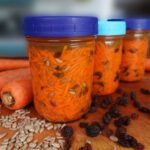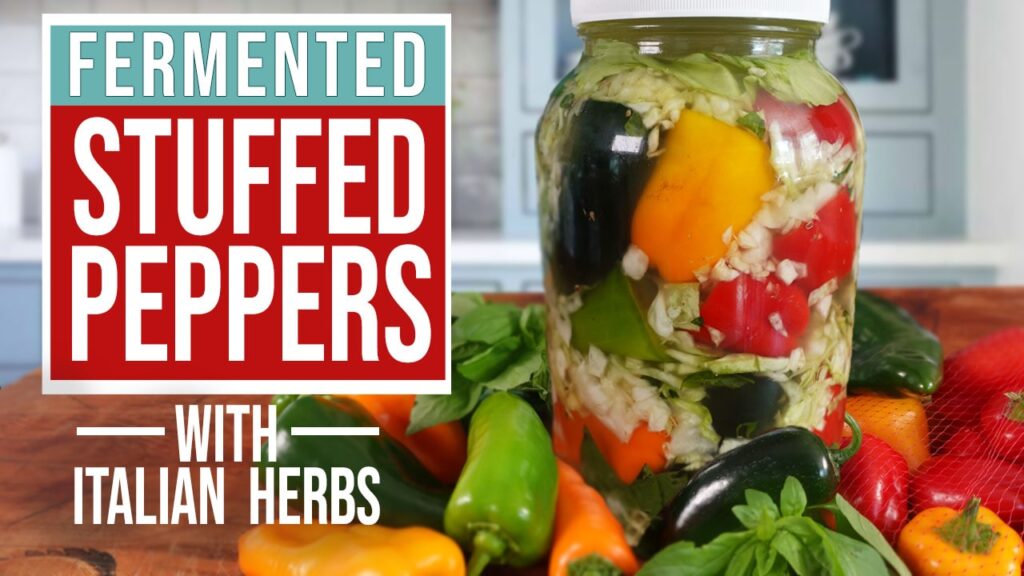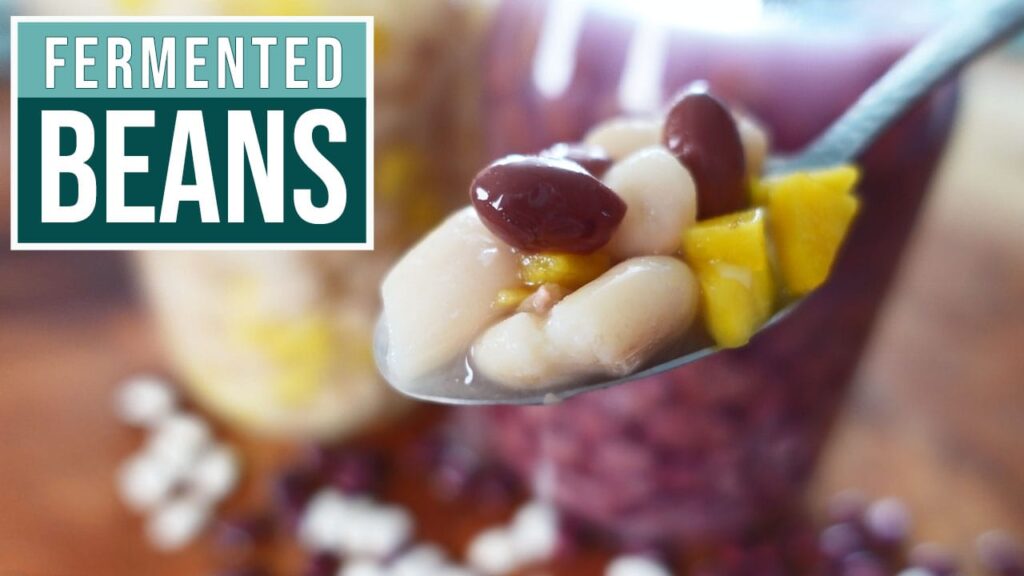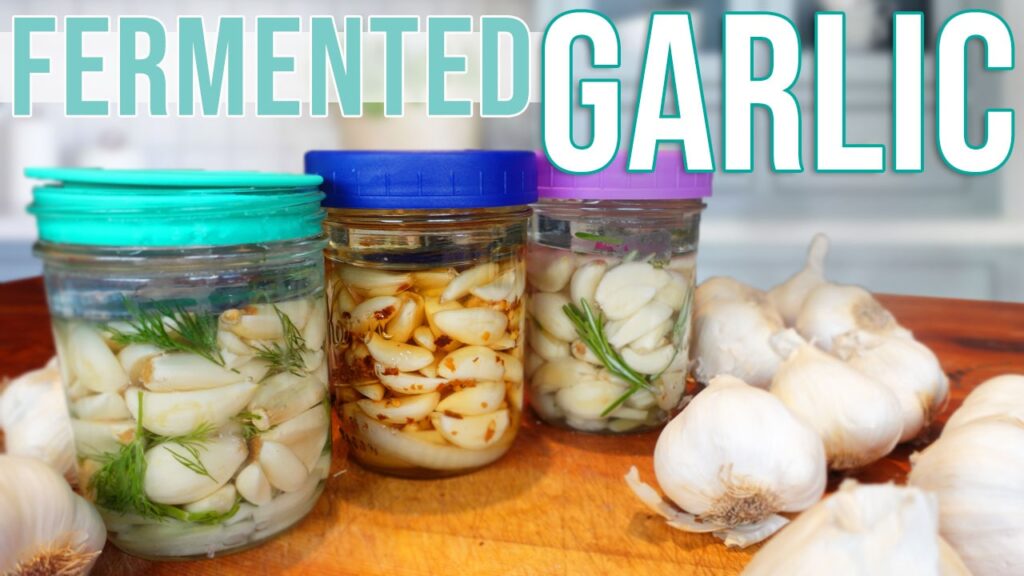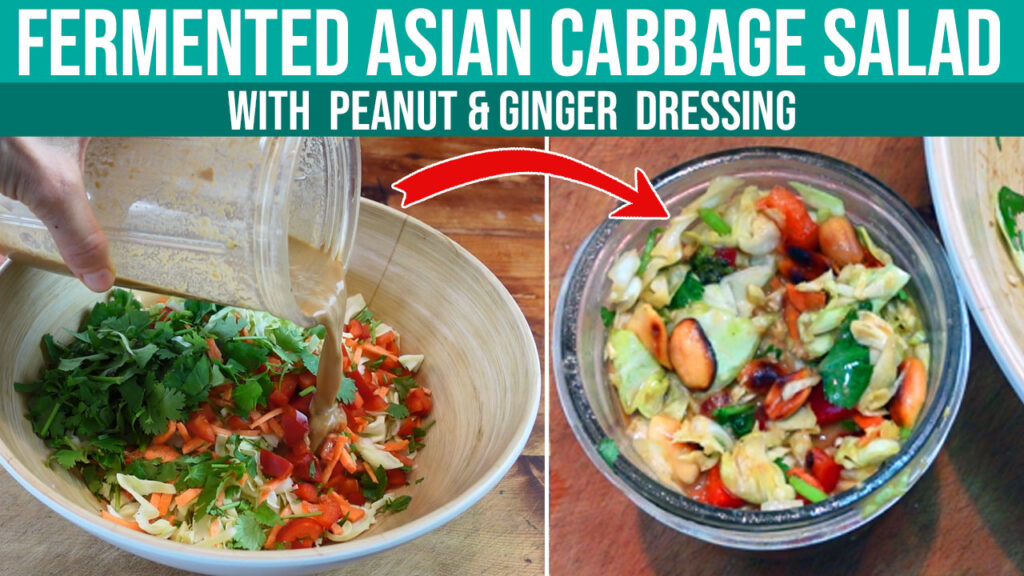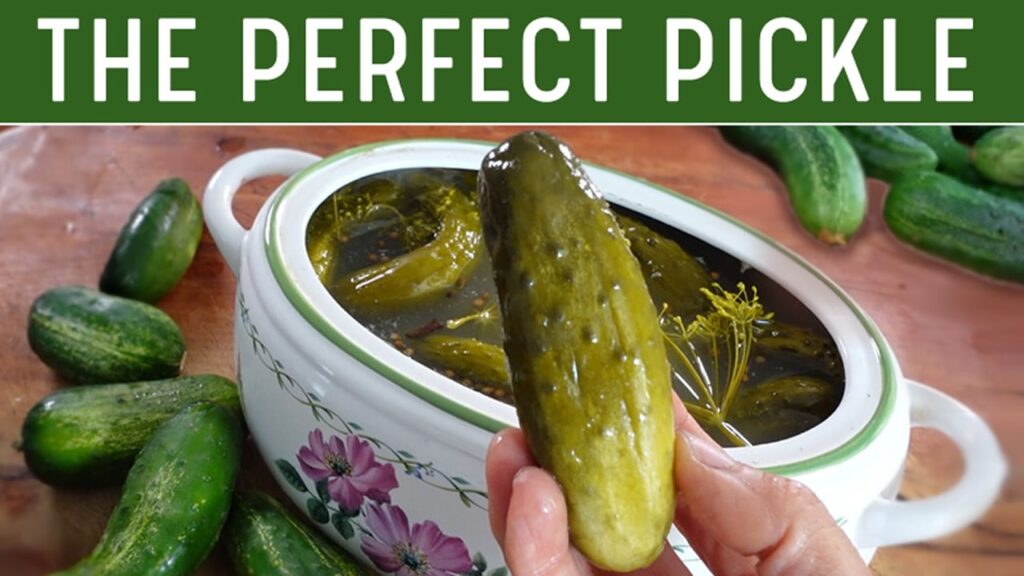
This “Fermented Carrot Salad” post contains affiliate links. Please read my affiliate disclosure.
Deliciously Healthy: Elevate Your Salad Game with Fermented Carrot Salad
Today, I’m excited to share with you a quick and easy fermented side dish: shredded carrot salad with raisins. This vibrant and flavorful salad is not only a feast for the senses but also a powerhouse of probiotics & nutrients that can transform your everyday meals into something truly special.
Because this shredded carrot salad recipe has a foundation of fermentation, it will become dense with beneficial bacteria that are called probiotics. Probiotics become abundant during the simple & quick fermentation process of this recipe. And when they are consumed, probiotics promote a healthy gut microbiome that aids digestion and supports the immune system..
If you’ve never fermented before, don’t be intimidated because the fermentation process of this carrot salad recipe couldn’t be more simple. In fact, this recipe is a great place to start if you are new to fermenting because it is so easy & quick. I will take through it step by step to build your fermenting confidence.
On the other hand, if you have experience with fermenting, you too will enjoy the simplicity of this fermented carrot salad. Let’s get to it!
Ferment Shredded Carrot Salad Along With Me!
In this fermented carrot salad recipe guide, I’ll take you through the entire process step-by-step. But if you want to ferment carrot salad along with me, watch the video below 😊
Ingredients Needed
Yield: 1 pint (475 g) Jar
Carrots
2.5 c (185 g)
Carrots are a true superfood, packed with an array of essential vitamins and minerals. The shredded carrot in this salad is an excellent source of beta-carotene which is converted into vitamin A in the body and plays a crucial role in supporting eye health, immune function, and skin health. Additionally, carrots are rich in fiber, which aids in digestion and promotes a feeling of fullness.
Raisins
1/4 c (50 g)
Raisins on the other hand, are a natural source of antioxidants and provide a delightful sweetness to balance the crunch of the carrots. They are also a good source of iron, which is essential for the production of red blood cells and the transport of oxygen throughout the body.
Sunflower Seeds
2 tbsp (25-30g)
Sunflower Seeds are a great source of vitamin E, which is known for its antioxidant properties. This means that consuming sunflower seeds can help protect our cells from damage caused by harmful free radicals. Additionally, these seeds are rich in healthy fats, including monounsaturated and polyunsaturated fats, which can help lower bad cholesterol levels and reduce the risk of heart disease.
Cumin Seeds
1/2 tsp (1 g)
Just a pinch of these tiny seeds can transform any recipe. The earthy and nutty undertones of cumin seeds add a flavor that is unmatched.
Salt & Water
1/4 tsp (1-2g) Salt + 3/4 c (175 ml) Water
Use a salt that is free of added anti-caking agents since these chemicals can interfere with fermentation. It’s best to use water that is free of chlorine such as well water, filtered or bottled.
Optional Alternatives
Nuts Instead of Seeds
2 tbsp (25-30g)
Almond slivers/slices or walnut pieces can also be a delicious and healthy addition if you choose not to add sunflower seeds.
Herbs Instead of Cumin
1 tsp (1-2 g)
Not a cumin fan? No problem! Make this fermented carrot salad with either dried dill weed or an Italian spice blend instead. Yum!
How To Make Fermented Carrot & Raisin Salad
This is such a simple recipe it’s hard to believe it’s so nutritious and probiotic rich! Follow these easy steps….
Step 1: Prepare The Carrots
First we’ll clearly need some carrots since they are the star ingredient. I like to peel mine because the skins have a bitter flavor, but you don’t have to if you prefer otherwise.
Next, shred the carrots with either a food processor or hand grater, then add them to a mixing bowl

Step 2: The Additions
Add the raisins and sunflower seeds to the bowl of shredded carrots. Remember you can substitute the sunflower seeds with almond slivers or walnut pieces.
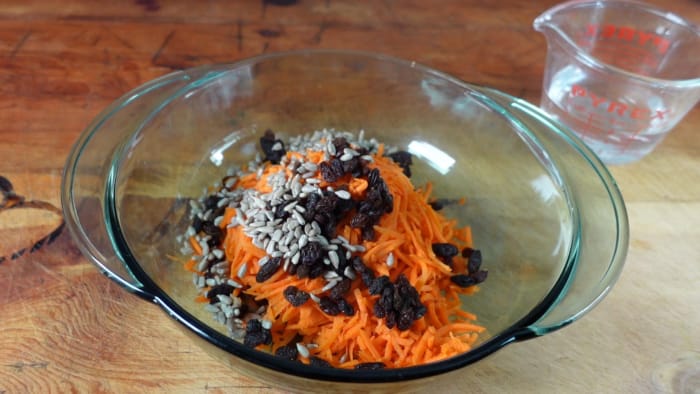
Step 3: Prepare The Cumin Seeds
If you’re going to use whole cumin seeds, you’ll need a little spice grinder to freshly grind them. Once ground, sprinkle over the other ingredients in the bowl.
The fresh grinding of the seeds is responsible for explosive flavor, incredible aroma and the release of bioactive compounds such as anti-inflammatory polyphenols.
Alternatively, you can add dried dill weed or an Italian seasoning blend if you choose not use cumin seeds. Using either of the herb flavors will create a delicious fermented carrot salad!

Step 4: Prepare The Brine
Add the salt to the water and mix thoroughly to incorporate the two. Oh and did I mention this is a low sodium recipe? It is!

Next, pour the brine over all the contents in the bowl.
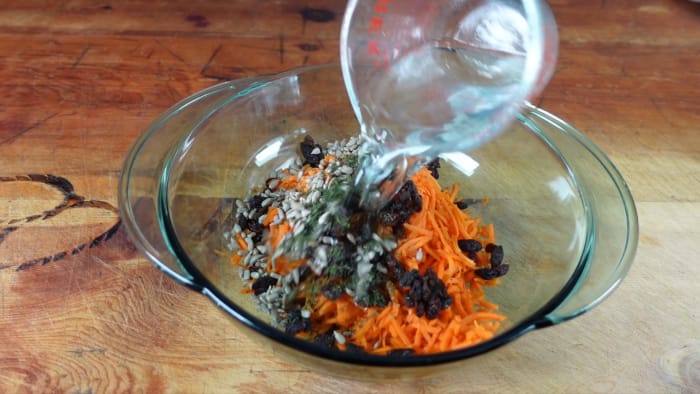
Step 5: Mix It Up
With clean, washed hands, toss all the ingredients around in the bowl and make sure everything becomes coated with the brine.

Step 6: Prepare The Equipment
Before loading the jar, wash it in hot soapy water. There is no need to sterilize the jar, hot soapy water is sufficient. Remember to wash the fermenting weight as well.
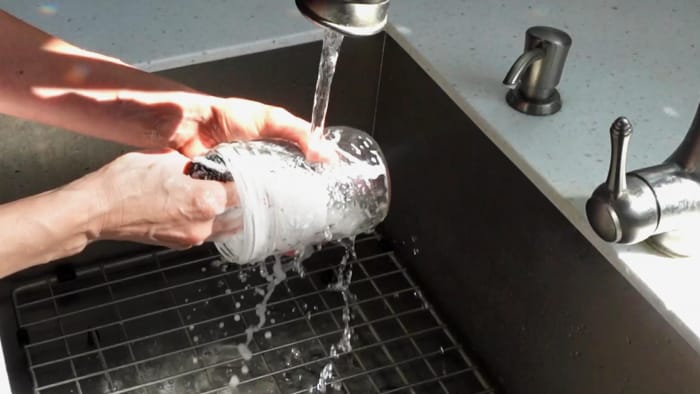
Step 7: Load The Jar
Place a couple of handfuls in the jar. I like to use a canning funnel when loading the jar because it significantly reduces spilling.
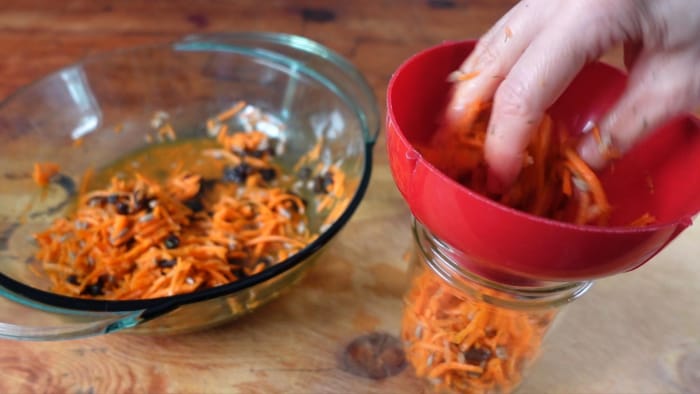
Next, I’m going to use this little tart tamper to pack the mixture down.

Add 2 more handfuls of the carrot mixture and pack down again.
Lastly, add the remaining contents from the bowl and press down once more. It should be nice and soupy by time all the contents are added.
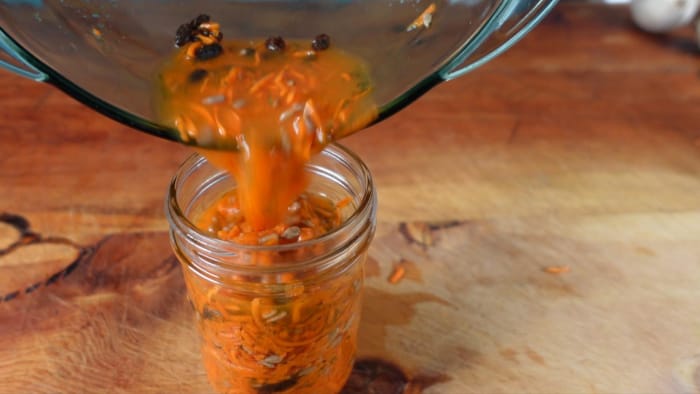
Step 8: Add The Fermenting Weight & Lid
Add the fermenting weight and press it down firmly. If you don’t have a fermenting weight, don’t fret. With this particular recipe, it’s ok not to use one.
Question: Why can I opt out of using a fermenting weight with this recipe and not others? Because this recipe ferments for such a short period of time, no mold will have an opportunity to develop.
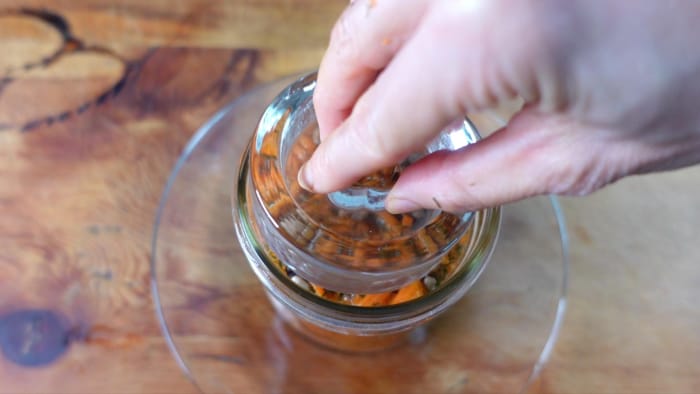
Place a loose lid on the jar.
The loose lid will allow for the fermentation gasses to escape which eliminates the need to burp the jar.
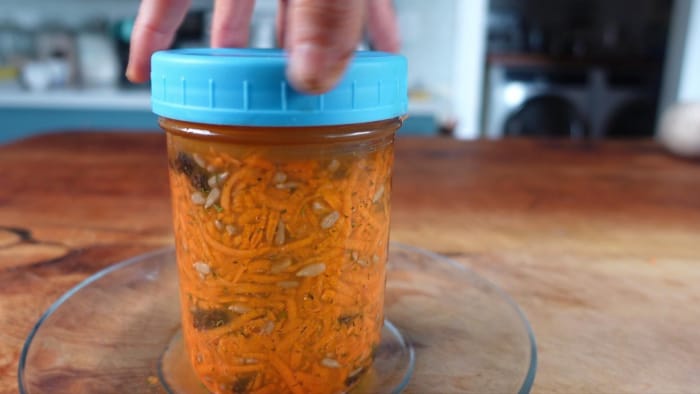
The Fermentation Period
Leave on the counter to ferment at room temperature for 24 to 48 hours. A towel or a plate placed underneath will catch the brine overflow that will occur once the fermentation gets going.
Depending on where you live in the world and the environmental conditions, the fermentation speed can vary. In temperate climates, 48 hours is the optimal fermentation period because it produces the best flavor without over-fermenting. I’ll explain what over-fermenting is coming up…
However, if you live in a hot & humid climate, give the carrot salad a taste test around 24 hours. You may find that at 24 hours, it already has that perfect zingy flavor created by the fermentation process. This is because extra warm environments speed up the rate of fermentation.
Whether your carrot salad has been fermenting for 24 or 48 hours, if you taste it and it has that strong fermentation zingy-sour flavor, go ahead and end the fermentation. But if you feel it needs a little more pop, allow it to ferment another day on the counter, simply follow your pallet.

The Magic Hour
For most temperate climates, 48 hours is where the fermentation flavor magic happens. The carrot salad will transform from tasting ‘pretty good’ at 24 hours to ‘wow’ at 48! I don’t recommend fermenting longer than 48 hours because it can result in over-fermentation. I’ll explain what over-fermentation is in just a moment.
Ending The Fermentation & Storage
- To end the fermentation, first remove the fermenting weight. Then with a clean fork, reach in and take a bite!
- To store, keep the weight out of the jar and place a tight lid on. Keep it in the refrigerator where it will last about 7 to 10 days before over-fermentation takes place.
What Is Over-Fermentation?
Over fermentation does not mean spoil or bad. Rather in the context of how I’m using it, it means too sour.
Here’s the science: When foods contain natural sugars, the beneficial bacteria responsible for the fermentation, feed on those natural sugars at an exponential rate. As the good bacteria feed, they also release lactic acid as their byproduct.
Lactic acid is a good thing and is one of the components that makes for a safe fermentation, plus it’s the source of that signature zingy-sour flavor fermented foods are known for. But too much lactic acid can make the final product too sour for pleasurable eating.

In context to this fermented carrot salad recipe, carrots are more abundant in natural sugar compared to let’s say, cabbage used for sauerkraut. In addition to the high natural sugar content, shredding the carrots exposes the carrot flesh even more-so than if they were cut into spears or sticks. This shredding grants faster and easier access to the natural sugars for the good bacteria (probiotics) to feed on, thus increasing the rate of fermentation.
When the rate of fermentation is increased, so is the output of lactic acid, resulting in high amounts in a short period of time. Although harmless, too much lactic acid in a fermentation diminishes the enjoyment factor.
Therefore with this carrot salad recipe, end the fermentation within 48 hours, store it in the refrigerator, and consume it sooner than later as to reap the delicious flavor within the perfect window of time.
Serving Suggestions and Pairing Options
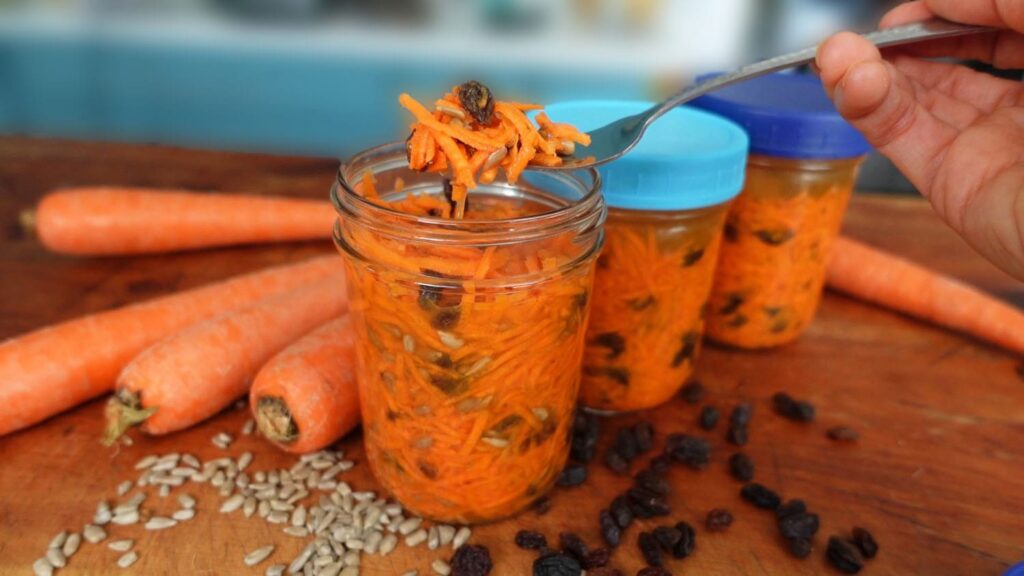
This fermented carrot salad with raisins is a versatile side dish that can be enjoyed in a variety of ways. It pairs beautifully with grilled or roasted meats, such as chicken, pork, or salmon. The sweetness and crunch of the salad helps balance the richness of the protein and provides a pleasurable compliment of flavors.
For a vegetarian or vegan option, the fermented carrot salad can be served as a meal compliment, perhaps alongside a hearty grain like quinoa or bulgur wheat, or as a topping for a bed of mixed greens.
Regardless if you pair it with a meat or a vegan dish, you can incorporate the fermented carrot salad into just about any meal, adding a flavorful, probiotic and nutritious component.
So, what are you waiting for? Grab those carrots, raisins, plus a few other simple ingredients, and get fermenting! Bon appétit!
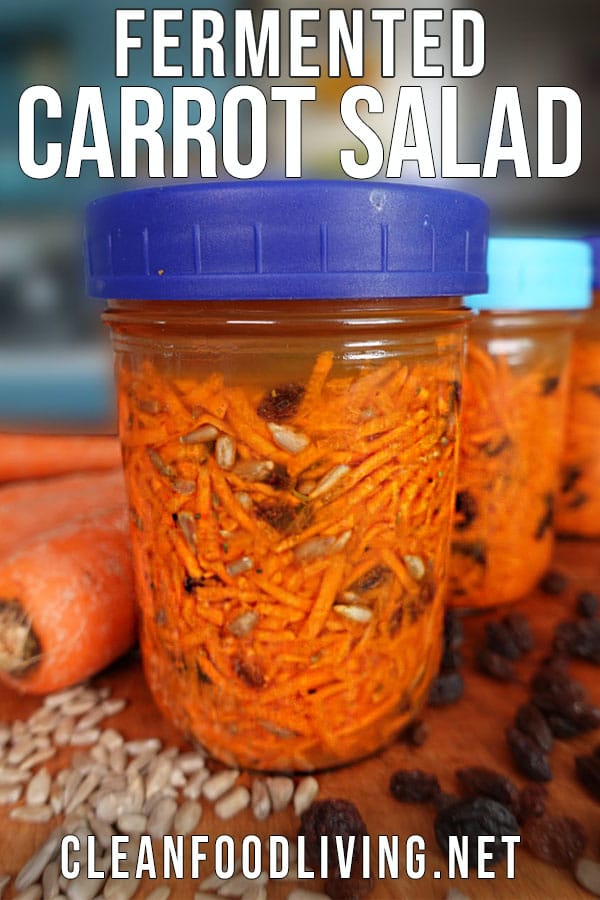
Fermented Carrot Salad with Raisins
Equipment
- 1 Wide Mouth Jar + Lid pint size or 475 ml
- 1 Fermenting Weight optional
- 1 Spice Grinder optional
- 1 Tamper optional
- 1 Canning Funnel optional
Ingredients
- 2.5 c Carrots Shredded
- ¼ c Raisins
- 2 tbsp Sunflower seeds
- ½ tsp Cumin Seeds
- ¼ tsp Salt Use a salt that does not contain anti-caking agents
- ¾ c Water
Optional Substitutions
- 2 tbsp Chopped walnut pieces or almond slivers (Instead of sunflower seeds)
- 1 tsp Dried dill weed OR Italian spice blend (Instead of cumin seeds)
Instructions
Step 1: Prepare The Carrots
- Shred the carrots with either a food processor or hand grater, then add them to a mixing bowl.You may opt to peel the carrots, but it is not required.
Step 2: The Additions
- Add the raisins and sunflower seeds to the bowl of shredded carrots. Remember you can substitute the sunflower seeds with almond slivers or walnut pieces.
Step 3: Prepare The Cumin Seeds
- If you’re going to use whole cumin seeds, you’ll need a little spice grinder to freshly grind them.The fresh grinding of the seeds is responsible for explosive flavor, incredible aroma and the release of bioactive compounds such as anti-inflammatory polyphenols.Once ground, sprinkle over the other ingredients in the bowl.
- Alternatively, you can add dried dill weed or an Italian seasoning blend if you choose not use cumin seeds. Using either of the herb flavors will create a delicious fermented carrot salad!
Step 4: Prepare The Brine
- Add the salt to the water and mix thoroughly to incorporate the two.
- Pour the brine over all the contents in the bowl.
Step 5: Mix It Up
- With clean, washed hands, toss all the ingredients around in the bowl and make sure everything becomes coated with the brine.
Step 6: Prepare The Equipment
- Before loading the jar, wash it in hot soapy water. There is no need to sterilize the jar, hot soapy water is sufficient. Remember to wash the fermenting weight as well.
Step 7: Load The Jar
- Place a couple of handfuls in the jar. I like to use a canning funnel when loading the jar because it significantly reduces spilling.
- Next, use a little tart tamper to pack the mixture down in the jar.
- Add 2 more handfuls of the carrot mixture and pack down again.
- Lastly, add the remaining contents from the bowl and press down once more. It should be nice and soupy by time all the contents are added.
Step 8: Add The Fermenting Weight & Lid
- Add the fermenting weight and press it down firmly. If you don't have a fermenting weight, don't fret. With this particular recipe, it's ok not to use one.
- Question: Why can I opt out of using a fermenting weight with this recipe and not other fermentation recipes? Because this recipe ferments for such a short period of time, no mold will have an opportunity to develop.
- Place a loose lid on the jar.The loose lid will allow for the fermentation gasses to escape which eliminates the need to burp the jar.
The Fermentation Period
- Leave on the counter to ferment at room temperature for 24 to 48 hours. A towel or a plate placed underneath will catch the brine overflow that will occur once the fermentation gets going.
- Depending on where you live in the world and the environmental conditions, the fermentation speed can vary. In temperate climates, 48 hours is the optimal fermentation period because it produces the best flavor without over-fermenting. *If you are not familiar with the term, an explanation is provided in the blog of what 'over-fermentation' is.
- If you live in a hot & humid climate, give the carrot salad a taste test around 24 hours. You may find that at 24 hours, it already has that perfect zingy flavor created by the fermentation process. This is because extra warm environments speed up the rate of fermentation.
- Whether your carrot salad has been fermenting for 24 or 48 hours, if you taste it and it has that strong fermentation zingy-sour flavor, go ahead and end the fermentation. But if you feel it needs a little more pop, allow it to ferment another day on the counter, simply follow your pallet.
Ending The Fermentation
- To end the fermentation, first remove the fermenting weight. Then with a clean fork, reach in and take a bite!
- To store, keep the weight out of the jar and place a tight lid on. Keep it in the refrigerator where it will last about 7 to 10 days before over-fermentation takes place.*If you are not familiar with the term, an explanation is provided in the blog of what 'over-fermentation' is.


